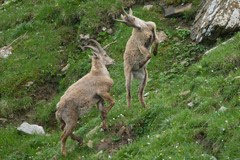JobMail
With JobMail CIPRA International informs you at irregular intervals about vacancies in organizations and institutions, which work in the field of protection and sustainable development in the Alps. JobMail does not consider any specific language, it is sent via eMail and free of charge. Subscribe here!
Current job offers:
Downloads
- Praktikum bei CIPRA International, ab Oktober 2025 (1.4 MB)
- Internship 2025 @ ALPARC (Deadline 30.05.2025)_en.pdf (256.6 KB)
- Stage 2025 @ ALPARC (Deadline 30.05.2025)_fr.pdf (260.3 KB)
- Ausschreibung Finanzvorstand @ POW Germany e.V..pdf (268.5 KB)
- Praktikum Kommunikation @ pro alps (Deadline 31.05.2025).pdf (216.5 KB)
- Projektleitung Politische Arbeit @pronatura (Deadline 01.06.2025).pdf (46.4 KB)
Listen to the CIPRA Podcast!
News from the Alps

alpMedia | Schaan, LI
CIPRA Yearly Symposium: marginal creativity...
This year's CIPRA Symposium focuses on the socio-economic margins of the Alps. Why "margins"? Because the nearest hospital is a far away and the post office is only open in the morning; because the towns and cities are beckoning, and nature is gaining more and more ground. The prevailing process of urbanisation has little in the way of prospects to offer these mountain regions, whose potential is already low.

alpMedia | Schaan, LI
Photo-shooting the Alps
Time for photographers of the Alps to show off their best shots! The Permanent Secretariat of the Alpine Convention is organising a photo competition with the aim of publishing the twelve best photographs in a calendar. There will also be a special prize for each published photograph.

alpMedia | Schaan, LI
A milestone for alpMedia
With its current issue CIPRA's three-weekly Newsletter alpMedia is going out to more than 25'000 people throughout the Alps for the first time. CIPRA launched the alpMedia information project during the International Year of the Mountains 2002, and at that time the Newsletter was sent to just 1'700 people.

alpMedia | Schaan, LI
Gran Paradiso National Park: what is causing young ibexes to die out?
Since the foundation of Italy's first national park in 1922, the Alpine Ibex has been preserved from extinction for the past 100 years or so. Now the ibex population at the Gran Paradiso National Park/I is seriously at risk. Three quarters of the young animals are dying during their first year of life. In 1993 the population totalled around 5'000 animals; today the population at the Gran Paradiso National Park is just under half that number. It is still unclear what is causing the death of the young bi-ungulates.